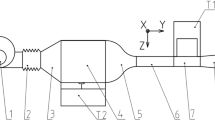Abstract
In thermal spraying technique, the changes in the in-flight particle velocities are considered to be only a function of the drag forces caused by the dominating flow regimes in the spray jet. Therefore, the correct understanding of the aerodynamic phenomena occurred at nozzle out let and at the substrate interface is an important task in the targeted improvement in the nozzle and air-cap design as well as in the spraying process in total. The presented work deals with the adapting of an innovative technique for the flow characterization called background-oriented Schlieren. The flow regimes in twin wire arc spraying (TWAS) and high velocity oxygen fuel (HVOF) were analyzed with this technique. The interfering of the atomization gas flow with the intersected wires causes in case of TWAS process a deformation of the jet shape. It leads also to areas with different aero dynamic forces. The configurations of the outlet air-caps in TWAS effect predominantly the outlet flow characteristics. The ratio between fuel and oxygen determine the dominating flow regimes in the HVOF spraying jet. Enhanced understanding of the aerodynamics at outlet and at the substrate interface could lead to a targeted improvement in thermal spraying processes.










Similar content being viewed by others
References
M. Pasandideh-Fard, V. Pershin, S. Chandra, and J. Mostaghimi, Splat Shapes in a Thermal Spray Coating Process: Simulations and Experiments, J. Therm. Spray Technol., 2002, 11(2), p 206-217
J. Wilden, A. Wank, and F. Schreiber, Wires for Arc and High Velocity Flame Spraying Wire Design, Materials and Coatings Properties, Thermal Spray Coatings: Surface Engineering Via Applied Research, C.C. Berndt, Ed., Montre′al, Que′bec, Canada (2000), ASM International, 2000, p 609-617s
M. Nakagawa, K. Shimoda, T. Tomoda, M. Koyama, Y. Ishikawa, and T. Nakajima, Development of Mass Production Technology of Arc Spraying for Automotive Engine Aluminum Alloy Valve Lifters, Thermal Spray Research and Applications, T.F. Bernecki, Ed., Long Beach, California (1990), ASM International, 1991, p 457-464
A. Pourmousa, A. Abedini, J. Mostaghimi, and S. Chandra, Particle Diagnostics in Wire-Arc Spraying System, Advances in Technology and Application, ASM International, Osaka, 2004, 2004, p 962-968
M.P. Planche, H. Liao, and C. Coddet, Relationships Between In-flight Particle Characteristics and Coating Microstructure with a Twin Wire Arc Spray Process and Different Working Conditions, Surf. Coat. Technol., 2004, 182, p 215-226
G. Jandin, H. Liao, Z.Q. Feng, and C. Coddet, Correlations Between Operating Conditions, Microstructure and Mechanical Properties of Twin Wire Arc Sprayed Steel Coatings, Mater. Sci. Eng., A, 2003, A349, p 298-305
X. Wang, D. Zhuang, E. Pfender, J. Heberlein, and W. Gerberich, Effect of Atomizing Gas Pressure on Coating Properties in Wire Arc Spray, Thermal Spray Industrial Applications, C.C. Berndt and S. Sampath, Ed., ASM International, 1994, p 587/592.2
G. S. Settles, Important Developments in Schlieren and Shadowgraph Visualization During the Last Decade, International Symposium on Flow Visualization, Daegu, Korea, June 2010, p 1-13
T.P. Davis, Schlieren Photography-Short Bibliography and Review, Opt. Laser Technol., 1981, 13(1), p 37-42
B. Atcheson, W. Heidrich, and I. Ihrke, An Evaluation of Optical Flow Algorithms for Background Oriented Schlieren Imaging, Exp. Fluids, 2009, 46(3), p 467-476
K. Seemann, A. Fischer, and E. Lugscheider, Study on Atmospheric Plasma Spraying of Al2O3 Using On-Line Particle Monitoring, Surf. Coat. Technol., 2003, 168(2-3), p 186-190
G. Mauer, R. Vaßen, and D. Stöver, Comparison and Applications of DPV-2000 and Accuraspray-g3 Diagnostic Systems, J. Therm. Spray Technol., 2007, 16(3), p 414-424
S. Zimmermann, K. Landes, and J. Schein, PSI: An Innovative Method to Determine and to Classify Particles During the Thermal Spray Process, ITSC2008, Thermal Spray Industrial Applications, ASM International, Maastricht, 2008
T. Streibl, T. Duda, and K. D. Landes, Diagnostics of Thermal Spray Processes by In-Flight Measurement of Particle Size and Shape with Innovative Particle-Shape-Imaging (PSI) Technique, Proceedings of SPIE, High-Speed-Imaging and Sequence Analysis III, San José, California, USA, 2001, p 45-52
W. Pellkofer, J. Zierhut, A. Sagel, T. Haug, and K. D. Landes, Verification of Particle Flux Imaging (PFI), an In-situ Diagnostic Method. ITSC2001, ASM International, p 28-30
S. Zimmermann, E. Vogli, M. Kauffeldt, M. Abdulgader, B. Krebs, B. Rüther, K. Landes, J. Schein, and W. Tillmann, Supervision and Measuring of Particle Parameters During the Wire-Arc Spraying Process with the Diagnostic Systems Accuraspray-g3 and LDA (Laser-Doppler-Anemometry), J. Therm. Spray Technol., 2010, 19(4), p 745-755
C. Moreau, J.-F. Bisson, R.S. Lima, and B.R. Marple, Diagnostics for Advanced Materials Processing by Plasma Spraying, Pure Appl. Chem., 2005, 77(2), p 443-462
P. Nylén, J. Lemaitre, J. Wigren, Sensitivity Study of Four On-Line Diagnostic Systems for Plasma Spraying, B. Marple, C. Moreau, Advancing the Science & Applying the Technology, ASM International, 2003, p 1101-1106
E. Lugscheider, A. Fischer, F. Ladru, C. Herbst, Plasma Sprayed Ceramic Coatings for Electrical Purposes-Necessity of Process Control Industrial Electronics Society, 1998. IECON ‘98. Proceedings of the 24th Annual Conference of the IEEE, 1998, 4, p 2284-2289
C. Moreau, M. Lamontagne, and P. Cielo, Influence of the Coating Thickness on the Cooling Rates of Plasma-Sprayed Particles Impinging on a Substrate, Surf. Coat. Technol., 1992, 53, p 107-114
H. Tabbara, S. Gu, D.G. McCartney, T.S. Price, and P.H. Shipway, Study on Process Optimization of Cold Gas Spraying, J. Therm. Spray Technol., 2011, 20(3), p 608-620
F. Durst, Fluid Mechanics: An Introduction to the Theory of Fluid Flows, Springer, Heidelberg, 2008
Acknowledgements
The authors gratefully acknowledge the financial support of the DFG (Deutsche Forschungsgemeinschaft) within the collaborative research Centre SFB708/TP-B3_TP-A1.
Author information
Authors and Affiliations
Corresponding author
Additional information
This article is an invited paper selected from presentations at the 2013 International Thermal Spray Conference, held May 13-15, 2013, in Busan, South Korea, and has been expanded from the original presentation.
Rights and permissions
About this article
Cite this article
Tillmann, W., Abdulgader, M., Rademacher, H.G. et al. Adapting of the Background-Oriented Schlieren (BOS) Technique in the Characterization of the Flow Regimes in Thermal Spraying Processes. J Therm Spray Tech 23, 21–30 (2014). https://doi.org/10.1007/s11666-013-0018-5
Received:
Revised:
Published:
Issue Date:
DOI: https://doi.org/10.1007/s11666-013-0018-5




